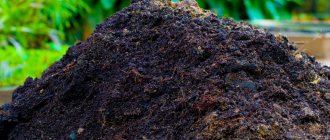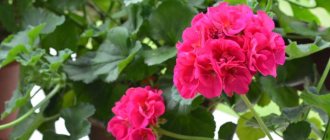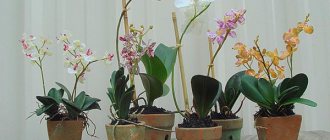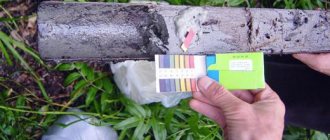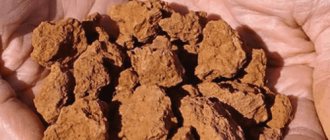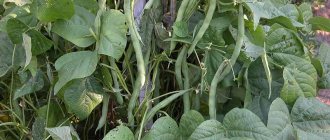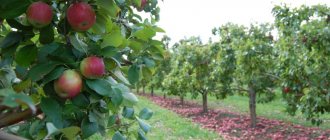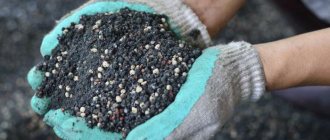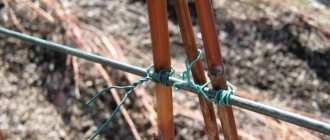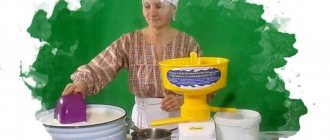Along with adding a large amount of organic fertilizers, compost, green manure, it is important to add a soil loosening agent. This can be either one component or several at the same time, depending on the condition of the soil and its type. The following disintegrants are known: perlite, vermiculite, sand, expanded clay, helium balls, peat, Christmas tree needles, pine bark, etc.
The plants that live in our gardens are not indigenous representatives of its biota. Vegetable, flower, and coniferous representatives of the flora are always brought to our summer cottages from outside, so that plants that have different requirements for growing conditions cannot end up there on their own. But I really want the dacha to be buried in the luxurious greenery of gardens, coniferous trees, ornamental, overseas plants and flowers, and not to be overgrown with dull but native sparse vegetation, more typical of meadows.
It is good if the soil is rich in nutrients, fertile, perfectly structured and aerated, and even fully meets the requirements of a particular crop. But this is such a rarity now! Due to our anthropogenic activities, every year we ourselves destroy the structure of the soil. What to do? How to correct the situation and return the structure? This can be either one component or several at the same time, depending on the condition of the soil and its type.
What is vermiculite
The hydromica group contains a mineral of volcanic nature with the inclusion of small particles of water. After heat treatment, they turn into steam, which explodes the pores and the material breaks up into scaly particles. Its origin allows us to classify this mineral as an environmentally friendly, natural mineral. The literal translation is consonant with the word “worm,” which is justified by the appearance of the mineral after heat treatment.
Vermiculite is a mineral of volcanic nature.
Vermiculite is a fertilizer that has the ability to retain life-giving moisture and added minerals, with their gradual release to the roots of plant organisms. The amount of liquid it absorbs is four times its own weight. The porous structure retains air, which is required for the development of plant crops and improves the aeration properties of planting soil.
Expanded vermiculite after firing acquires a porous, free-flowing structure. When added to the soil, the hygroscopicity and aeration properties of the soil mixture improve.
Using this substance helps:
- reduce the amount of watering;
- prevent the formation of a crust on the surface of the earth clod;
- accumulate useful substances that are later received by plant roots.
Substance concentration
The layered substance can be used as a covering material for storing flower bulbs and tubers, such as gladioli. They will not dry out, nothing will put pressure on the roots. But we must remember that it is not recommended to pour vermiculite into the soil by eye.
The concentration of the substance in the soil is important and depends on what plant the product is used for. To care for violets or begonias, one fifth of the total composition of the soil will be enough. For plants of the Palm family, the concentration is no more than 30% of the total volume of the substrate. For Dieffenbachia and hibiscus, the concentration should be the same as for violets.
Popular: Use of cytokinin paste for orchid growth
Using standard agricultural technology, it is not recommended to increase the proportions of vermiculite to more than one to one in relation to the soil in the pot. The highest concentration should be 50%. This fertilizer is suitable for succulents. Vermiculite can also be used as compost for garden beds, mixing it with peat, manure and straw.
Application
The product is recommended for use on almost any crop that is grown in open and closed ground. It accelerates the ripening of berries, vegetables and fruits by one to two weeks, ahead of schedule. At the same time, the yield increases by 20–30%. When using fines, the gardener should wear a respirator due to the dust.
Plants grown in beds with added vermiculite are less susceptible to fungal diseases and bacterial infections. Before mulching, agronomists recommend fluffing up the substrate, spreading the product over the surface and burying it in the soil.
For seedlings
First of all, gardeners use the mineral to germinate seeds. It acts as a growth biostimulator. The mineral and planting material are poured into a bag, filled with water and waited until the seeds begin to germinate. At this time, the package is put away in a warm place.
After the first shoots hatch, the seeds are planted in a mixture of soil and vermiculite in a ratio of one to two. This procedure will allow the gardener to quickly obtain seedlings and stimulate its immunity. Vermiculite can also be used as a drainage layer. They line the bottom of a box with seedlings; you can alternate the mineral with layers of sand.
The use of this substance will allow you to grow seedlings ten days faster than using conventional liquid fertilizers. For growing cucumbers, bell peppers and tomatoes, a suitable proportion of five parts soil, two vermiculite and three humus.
Mulching
For mulch, agronomists recommend purchasing large fractions. The consumption per plant will be from three to ten liters of product. Three liters is suitable for a small shrub, and 10 will allow you to mulch a large tree. It is also used for rooting cuttings mixed with liquid fertilizer.
Use for cuttings
The mineral is useful when transplanting plants into open ground. To accelerate growth and productivity, a mixture of half peat and the same amount of mineral matter is prepared. This will speed up the harvest time by about two weeks.
Popular: Proper spring planting of green manure in a greenhouse and in the ground
The resulting mixture can be used for small plants, when planting potatoes or shrubs. When transplanting seedlings, eight teaspoons of the resulting mixture are poured into each hole. Fertilizing potatoes requires greater concentration. At least a glass of the substance should be poured into each hole. A mixture of vermiculite and peat will increase the yield of plums, apples and berry crops. When transplanting large shrubs, use up to three liters of mixture in one hole.
Application for clay soil
Experienced agronomists recommend using this useful substance in areas that have clay soil.
Such soil does not allow deep penetration of water, so the root system is poorly saturated with moisture. It contains few useful substances, and the soil is dense, heavy and poor. It is difficult for plant roots to develop in clay. The bushes also lack air. All this affects productivity.
The addition of vermiculite allows you to change the properties of the soil and improves plant nutrition. For fertilizer, it is recommended to sprinkle crumbs over the area at the rate of two liters per square meter. The gardener must spread this product in an even layer, and then dig it up. Then the clay soil is fertilized with manure and straw.
Using vermiculite in hydroponics
When planting plants, this product is used in hydroponics. It contains many useful substances, which is why it is so popular among flower growers and gardeners. The natural substance is often mixed with expanded clay or gravel. It is possible to mix the mineral with perlite or other similar components.
Composition and appearance
Externally, the substance is a loose mixture with shades ranging from silver, gold to bronze. Each individual particle, when viewed closely, has a layered-porous structure. Under the influence of high temperatures, the mineral swells and increases in volume. The unique process of metamorphosis during heat treatment substantiates the uniqueness of the substance and its properties.
Let's look at the composition of vermiculite. This mineral naturally contains a unique complex of trace elements:
- iron and calcium oxides;
- traces of magnesium;
- silicon;
- potassium
- aluminum
There are impurities of manganese oxide, chlorine and sulfur compounds. The chemical content may vary in percentage based on the origin of the mineral. The substance is chemically inert, which allows it to be used for a long period.
Thanks to its unique properties, it is used to impart looseness to the soil, increase hygroscopicity and aeration properties, which is why vermiculite is needed in crop production. Vermiculite, photo:
What are the benefits of vermiculite?
We have already written that vermiculite contains various microelements. They are necessary for the plant to develop normally. But this mineral cannot be classified as a fertilizer.
- Vermiculite accumulates nutrient ions added to the soil, releasing them to the plant gradually.
- Does not decompose or rot under the influence of microorganisms.
- It has sound-insulating and heat-saving properties.
- It can absorb moisture, giving it to the roots of the plant as needed.
- Does not react with acids and alkalis.
- It is a natural, environmentally friendly material.
You may be interested in: Fertilizer for Zamioculcas
Expanded vermiculite is actively used for planting garden flowers, exotic and fastidious plants, and coniferous trees. You can use it for indoor plants, as well as for planting seedlings.
How to mine
Places where ore is mined to produce a product suitable for use in agriculture include:
- Kazakhstan;
- Siberian field;
- Kola Peninsula;
- Far Eastern mine;
- Ural quarries.
After mining, the ore is treated at high temperatures and packaged.
Expert opinion about Vermiculite
Adding vermiculite to planting soil helps solve several problems at once. The effectiveness of using vermiculite to improve aeration and reduce plant water needs has been scientifically proven. The substance eliminates the need for additional calcium and potassium supplements. With the help of vermiculite, it is possible to solve the problem of the development of fungal diseases.
Anatoly Baykov
Composition of useful mineral
The chemical composition of the mineral includes oxides of a number of elements from the periodic table:
- silicon;
- calcium;
- potassium;
- magnesium;
- gland;
- manganese;
- aluminum
In addition, it contains various impurities - chlorine, sulfur. In terms of its properties, vermiculite is chemically inert. For this reason, the mineral is not able to interact with solvents, alkalis and acids of organic origin.
Thanks to this, the material has a beneficial effect on the development of plants, because it is not able to change the reaction of the environment.
Properties
The main properties of expanded vermiculite:
- high moisture absorption capacity;
- low hygroscopicity;
- does not decompose, has a low level of abrasion;
- prevents the development of decay processes;
- increased thermal insulation properties;
- chemical inertness;
- ability to act as a soil loosener;
- breathability.
Vermiculite is used to add looseness to the soil.
What is vermiculite used for?
The main purpose of vermiculite for crop production is to absorb and retain water in the soil. In addition, vermiculite for plants:
- prolongs the effect of fertilizers;
- has thermal insulation properties;
- improves soil structure - the soil becomes loose, airy, air- and water-permeable;
- promotes the active development of the root system, making the plant strong and stress-resistant, including due to its heat-insulating properties.
Vermiculite has a high water absorption coefficient - 400-530% (100 grams of vermiculite absorb 400-530 ml of water). It easily absorbs moisture and releases it just as easily, creating an optimally moist environment for feeding plant roots.
The areas of application of vermiculite are varied and are not limited to crop production. Vermiculite is used to make thermal insulation products, sound-absorbing materials, including in aviation and automotive industry, lightweight concrete, and decorative plaster mortars. In addition, it is used as a filler in the manufacture of wallpaper, rubber, plastics, paints, pesticides, and in the production of antifriction materials. Vermiculite is a good adsorbent for gaseous and liquid industrial waste.
Material quality criteria
Usually, when vermiculite is packaged, the manufacturer indicates on the packaging the quality indicators of the substance and its compliance with accepted quality standards.
GOST vermiculite contains the main criteria regarding product quality:
- percentage of moisture absorption;
- maximum permissible temperature conditions;
- thermal conductivity characteristics;
- resistance to low temperatures;
- swelling percentage;
- organic mineral content;
- toxicity index;
- volume, mass;
- warranty obligations.
Sales of vermiculite
Vermiculite is supplied to retail sales in small packaging from 250 ml to 3 liters. The Russian market is represented by the following brands:
- "Fasco".
- "Hera."
- "Eco garden".
- "Gardens of Aurica".
- Peter Peat.
- Florizel.
The average cost of 1 liter varies from 30 to 40 rubles.
At the same time, vermiculite can be purchased in large quantities: 10-50 liters. To do this, you should contact one of the large gardening or construction centers (yes, this is also a good building material). In this case, the cost of 1 liter will also reach 30 rubles.
As for vermiculite producers, the bulk of this concentrate is made in the USA and South Africa, and the volumes have only increased recently. Typically, the raw material base of vermiculite abroad is significantly limited on a territorial basis. Despite this, the use of the mineral remains profitable.
Various online stores are engaged in the implementation of wholesale supplies, including SibEcoVer, Lotos. The cost of 1 kg will be 25-35 rubles.
Varieties of mineral
Depending on the place of extraction and processing method, the quality characteristics of the product change. After vermiculite has expanded under the influence of heat treatment, it is suitable for use in a complex of agrotechnical measures.
Based on vermiculite extracted from the Ural Mountains, a product enriched with magnesium and a small amount of iron is obtained. It is light in color with a slight yellowish tint and is suitable for hydroponically growing vegetable and flower crops.
Varieties of the mineral depend on the place of extraction
In Kazakhstan, ore is mined and has a light grayish tint. The low content of ferrum allows it to be used when growing potted and tub crops and seedlings in open ground conditions.
Altai pink leaf vermiculite is rich in:
- potassium;
- ferrum;
- magnesium
An excellent option for growing seedlings of nightshade crops and germinating seed material.
Scandinavian and Kola, due to their high content of sodium, potassium, magnesium and calcium, after crushing, are used in conjunction with peat for the purpose of germinating seed products and rooting cuttings.
How to properly use ecocube with vermiculite
Recently, entire kits have appeared on sale, designed for growing seedlings of different crops in the most comfortable environment for them. Among them is the ecocube, a universal kit that includes a square-shaped wooden box with dimensions of 8x8x8 cm, a paper cup, nutrient soil and seeds for planting.
Vermiculite is also included in this composition - as an auxiliary agent for loosening the soil and ensuring guaranteed germination. And in principle, growing seedlings using an ecocube is no different from that which involves the use of available means, except that the composition of the soil mixture is selected specifically for the crop seeds included in the set.
Pros and cons of fertilizer
Let's look at the undeniable advantages:
- the ability to improve the quality characteristics of soil mixtures;
- reduction of acidity in acidified soils;
- high moisture absorption capacity;
- content of microelements in its composition;
- preventing the proliferation of pathological microorganisms;
- increasing the aeration of soil layers;
- preventing the formation of a cortical film on the surface;
- protection of the root system from hypothermia and overheating;
- Possibility of use in hydroponics;
- the ability to extend the shelf life of the harvested crop;
- predisposition to long-term use.
Vermiculite reduces acidity in acidic soils
Among the minor disadvantages are:
- slow release of moisture, need to be used together with perlite;
- the ability to hide the onset of development of the larvae of some parasitic insects;
- ability to alkalize soils;
- Rarely, fine fractions create a dust cloud that is hazardous if inhaled.
Other features of vermiculite
What is vermiculite? A similar question may arise for many newcomers to the field of plant growing who hear this definition for the first time. Experienced people are aware of the benefits of this mineral and know some of its features, which can be considered advantages:
- The material does not rot - it is indifferent to the effects of various pests, including fungi and microbes.
- These durable pebbles can be used for several years.
- Thanks to vermiculite, the soil becomes softer and more airy.
- This material contains chemical elements necessary for many plants.
- You can make compost with vermiculite.
- Once you add vermiculite to the potting soil, you can water the flowers less often than usual.
As for the period of use of vermiculite, this is quite an impressive figure - up to 10 years.
However, you shouldn’t throw away the old material either - just rinse it well, dry it, and then heat it in the oven or in a frying pan. Now it can be reused.
Where is vermiculite used?
The product is in demand in agricultural technology at many stages of plant cultivation. The scope of application depends on the fraction, place of its extraction and quality composition. Use vermiculite for seedlings, as described below. It is useful to add vermiculite to the substrate for potted crops; the mixture with its inclusions is not subject to caking, has better aeration properties, hygroscopicity and friability.
Germination of seeds and rooting of seedlings
Ultra-fine fractions are used for sowing the smallest seeds. Stir the seeds evenly in vermiculite of the smallest fraction. After this, seeds are sown in vermiculite on the prepared areas. Vermiculite, which must be pre-moistened, speeds up germination. In such a substrate, roots appear very quickly, rooting occurs quickly, and putrefactive processes do not develop.
After sowing the seed material, it will not be superfluous to sprinkle them with a fine fraction of the mineral.
Vermiculite is used for sowing seeds
This will help you avoid:
- development of blackening of the leg;
- mold formation;
- drying of the top layer of soil mixture.
For growing seedlings
The unique ability to absorb large amounts of liquid and slowly release it to plant roots has been used in growing seedlings of various crops. This feature is taken into account when preparing soil mixtures for picking and growing seedlings.
This substrate is characterized by increased aeration capacity, moisture permeability, and a high content of mineral elements.
Planting of germinated seeds in vermiculite mixed with soil in a ratio of 1:2 is carried out on the second day after the seeds hatch. In such soil, the development of seedlings of various crops is accelerated, thanks to optimal conditions for growth processes. Before rooting cuttings of various crops in vermiculite, it must first be moistened with settled water.
Storing tubers and bulbs
Do you use folk signs in gardening?
The middle fraction of the expanded mineral is successfully used for storing tubers - bulbous products, planting material, and young seedlings. To do this, pour the selected fraction of the substance into a container in a layer of 4 cm, lay the planting products, and cover them with the same layer on top. This method perfectly protects against overheating, hypothermia, the development of mold fungi, and pathogenic bacteria. Rodent pests will leave products stored using this mineral untouched.
Vermiculite is also used for drainage layer
Drainage
When growing tub crops, flowers in containers and pots, a large fraction of vermiculite is poured onto the bottom of the container as a drainage layer. The product should have a pinkish-orange color scheme, whitish options include excessive calcium for potting. Succulents like less humid conditions and tolerate saline soils. Before planting them, a fraction of 2-2.5 cm is poured onto the bottom of the container to fill a third of its volume with the expanded mineral.
Soil improvement
All fractions of this mineral can improve the condition of the soil composition:
- reduce moisture evaporation;
- loosen heavy soils;
- as a moisture sorbent before sowing lawn grass;
- reduce soil acidity.
Mulching
Mulch the open ground with a mixture of vermiculite and an organic component (chicken droppings, mullein). The choice should be made on medium-sized fractions. When growing plants indoors, a fine fraction of the mineral is used to cover the top soil layer, this helps reduce the amount of watering and prevents the earthen clod from drying out and the formation of a dense surface crust.
Vermiculite: what is it and what is it for?
This material is of exclusively natural origin, having a layered structure. Initially, before the vermiculite that is familiar to many, it looks different, having the appearance of plate-type crystals. If these crystals are heated, they will become like columns with a worm-like shape and scales on the surface - this is exactly the kind of mineral we are familiar with. In addition to summer residents and gardeners, builders use it, and also very successfully.
The size of the mineral varies and is usually divided into a number of fractions - from the largest, like peas, to the fraction that looks like dust. Typically, in vegetable growing and home floriculture, neither the first nor the fifth fractions are used to form the soil composition.
The substrate is interesting to look at, it is unusual to the touch, just pour a little into your palm, rub it between your fingers, you will feel its elasticity, strength, but at the same time pliability - it can be easily crumbled. Having such features, it is a kind of sponge that is able to absorb a lot of moisture, usually up to four or even five of its volumes, and retain this moisture in itself, slowly releasing it to the plants, thereby improving the quality of the soil.
In addition, the mineral, even during long-term storage, will not decompose or rot, it will not burn, will not emit unpleasant odors, it is absolutely safe in terms of containing various toxins, does not react with acids and alkalis, it is light and durable, and it contains a lot of useful microelements.
| Important. The substance retains moisture and substances dissolved in it, due to which it prolongs the effect of fertilizers, is itself a fertilizer, slightly deoxidizes the soil, reduces soil salinity, even rids the soil of some toxins and stimulates the growth of the root system. |
Due to the presence of the substance in the soil, the soil structure is improved, its moisture capacity and air permeability are increased, there are no sharp changes in soil temperature during the day and night, and the amount of harmful microflora in the soil is reduced. And all this together leads to increased productivity of various crops.
Photo: Gardeners use three fractions of the substance.
Composition of vermiculite for plants
After natural vermiculite is processed at the enterprise, it takes the form of layered flakes, very light in weight, which is exactly how we are used to seeing it.
In order to use the substrate in different ways, it is produced in the form of fractions of different sizes, which are unified by digital designations. The largest fractions are the size of a pea or even a small coin, and the smallest are the size of dust or sand.
The three most commonly used types of vermiculite
Typically, vegetable growers and flower growers use medium-sized fractions from the second fraction to the fourth.
- The smallest fractions are usually used in a mixture; this can be a mixture with river sand, ordinary soil or peat. Often this mixture is used for sowing seeds.
- The middle fraction is usually used to increase the breathability of the soil and significantly increase its moisture capacity.
- The largest fractions of vermiculite are perfect for drainage, such as expanded clay, and sometimes vermiculite is simply mixed with expanded clay, thus increasing the moisture capacity of the drainage layer.
Three fractions of vermiculite are common. The first has the KVV-1 normalization - the fraction is considered fine-grained and its particle size is about 0.5 mm or a little higher. The second fraction is designated as KVV-2, it is considered medium-grained and its particles are larger - from 0.7 mm to 0.5 cm Well and the third fraction is called coarse-grained, is labeled KVV-3 and its particles have a size of 0.5 to 1 cm.
What plants is it suitable for?
The product is best suited for accelerating the emergence of roots on cuttings and growing crops with weak roots.
Vermiculite is indispensable for indoor plants
Vermiculite is used for flowers of various varieties and growing methods:
- vermiculite for violets;
- bromeliads;
- succulents;
- vermiculite for orchids and other types of epiphytes;
- pelargoniums;
- bulbous.
Vermiculite is indispensable for indoor plants; with its help, the life of the earthen ball is extended. Its addition prolongs the retention of moisture and protects the soil from souring due to excessive watering.
Cucumbers in vermiculite develop faster, their root system is protected from hypothermia, and the beneficial substances preserved in the mineral gradually pass to the plant through absorption through the roots.
Vermiculite for tomatoes is used at all stages of cultivation - from seed germination to mulching flowering and fruiting bushes. This universal remedy is a reliable support in crop production.
Protects roots from rotting
For indoor plants, the main danger is watering errors. If you water abundantly, the moisture may stagnate, the roots will rot in such a humid environment, and the flower will die. Vermiculite absorbs excess liquid and maintains a normal level of moisture in the earthen coma. Plus, this mineral is like a sterile environment in which bacterial infections, fungi, mold and root rot do not appear. Healthy roots are an important condition for plant growth and development.
Seedlings and sprouts are often rooted in Vermiculite. It creates a favorable environment for root growth, maintaining the necessary moisture and cleanliness.
Instructions for use
A mineral that is excellent for use in the cultivation of various plants. In order not to harm the plants, you need to learn how to use vermiculite depending on the crop being grown and the stage of development at which it is added.
The mineral is used in the cultivation of various plants
How much vermiculite to add in different situations:
- when preparing nutrient soil mixtures for the purpose of growing potted crops and seedlings - 10-15 percent of the total volume of ingredients;
- for berry, flower and decorative cuttings, use peat substrate and vermiculite, the proportions are 1:1;
- in order to prevent hypothermia of the roots in winter, add from 6 to 9 kg per square meter to the soil of the tree trunk circles;
- When making compost, 10 kg of mineral additive per 100 liters of organic matter is sufficient to accelerate enzymatic processes.
What is vermiculite and what are its benefits for plants?
Vermiculus is literally translated from Latin as “worm,” and this basis for the name of the natural mineral, which is vermiculite, was not chosen by chance. Thus, with prolonged heating of a fine mineral fraction, its particles become deformed, as a result of which they become similar to curved earthworms. By the way, heating to certain temperatures is a mandatory step for processing raw materials, which exfoliate under the influence of heat, becoming almost weightless.
At the same time, five different vermiculite fractions are used in production (from the size of shell chips to coins), which then find application in various fields. And if we talk about gardening, then the best option is to use three fractions of the 2nd, 3rd and 4th groups. For what? Vermiculite has many beneficial properties that have the most beneficial effect on the plants grown on the site. Among them:
- Improving the aeration properties of the top layers of soil. Unfortunately, not every site can boast of ideal soil, equally suitable for germinating seeds and growing mature plants. In some cases, you even have to cultivate rocky soil, and vermiculite will be an excellent help here, making the soil lighter and airier. To do this, it is enough to simply add up to 10 spoons of raw materials (volume per 1 square meter) into the beds or pour several tablespoons into each hole, making the treated area an ideal environment for the full cultivation of seedlings or the quick and trouble-free emergence of seedlings.
- The vegetative method of propagation is widely used not only for garden and vegetable crops, but also for indoor crops. And since it is quite difficult for the fragile root system of separated cuttings not to rot even in the lightest soil mixture, it is recommended to grow it in pure vermiculite or in soil with a large amount of such an additive.
For the same reason, it is advisable to add raw materials to pots of adult ornamental plants such as anthuriums and orchids, since they are not suitable for growing in a regular substrate.
- Soil enrichment. It is no secret that vermiculite is used not only for loosening, but also for enriching the soil, providing it with essential potassium, magnesium, calcium, silicon, iron, aluminum and other substances. Of course, such feeding will not be enough for the entire growing period, but at the initial stage this is what is needed.
- Mulching is another area in which vermiculite is actively used, especially when it comes to growing fruit and berry trees.
So, per square meter there are about 6-8 liters of vermiculite mixture, which includes both a fine fraction and medium-sized mineral chips. To mulch shrubs you will need up to 3-5 liters, while for treating flower beds 2-3 liters will be enough.
By the way, covering pre-dug soil with such mulch will help reduce the number of waterings, and will also avoid negative consequences in case of return frosts.
Among other things, vermiculite is quite often used on the farm, using it to store crops. Thus, practice shows that vegetables and fruits immersed in mica crumbs retain their freshness much better, without being affected by rot and pathogenic bacteria for a longer time. Such unique features have a fairly simple explanation - the scaly surface of the mineral is capable of absorbing an impressive amount of moisture, on average about 400 ml for every 100 g. And it is this quality that makes it possible to eliminate stagnation of moisture, which often provokes the development of mold and putrefactive processes.
Vermiculite is simple and easy to use, affordable and non-toxic
How much vermiculite is needed for each plant?
The optimal amount of a substance for various crops is calculated depending on the growing method and plant type:
- the ficus, azalea, bromeliad, bulbous, malvaceae families require the addition of a substance in a fifth of the total volume;
- begonias, violets, peperomia and gardenias need 15-18% of the substance in the mixture;
- Growing cyperus, asparagus, palms and aspidistra often involves adding a third of the total soil volume.
Perlite
Perlite itself is volcanic glass that has been exposed to moisture over time and formed compounds similar to crystalline hydrates. Water slightly lowers the softening temperature of the mineral, which is used to transform it into a kind of hardened glass foam - expanded perlite. It is obtained from crushed source material by thermal shock at a temperature of 900–1100 °C. In this case, the mineral becomes plastic, and the explosively released water forms many tiny bubbles and its volume increases 4–20 times, and its porosity reaches 70–90%.
The finished product is light granules from light gray to snow-white. Due to its glass origin, it is quite hard, but very fragile - the granules are easily crushed into dust with your fingers. The resulting powder has strong abrasive properties; large pieces of high-density perlite can damage the skin. The scope of its application depends on the size of the fraction:
- construction - various brands of expanded perlite sand of a fraction of 0.16–5 mm (VPR - ordinary), as well as crushed stone 5–20 mm, density usually 75–200 kg/m³;
- agroperlite - the same construction material, only with large grains (VPK - large), fraction 1.25–5 mm, but some companies produce agroperlite according to their own specifications, for example, Zh-15, with grain sizes 0.63–5 mm and density not higher than 160 kg/m³;
- powder – VPP grade, fraction less than 0.16 mm, used for various filters.
Agroperlite is chemically neutral (average PH = 7), loose, granular, porous material that does not contain nutrients and soluble salts. It is not susceptible to chemical or biological decomposition (rot, mold); moreover, it itself protects plant rhizomes from various diseases, for example, root rot. An excellent sorbent (absorbs water over 400% of its own weight), is of no interest to insects and rodents.
How does the soil change after adding vermiculite?
Let's try to systematize the effect of vermiculite on the qualitative characteristics of the soil composition after its application:
When using vermiculite, soil aeration increases
- vermiculite in the garden can improve the soil, regardless of its original composition;
- soil aeration increases;
- growing in vermiculite prevents the earthen clod from drying out and its lower layer from acidifying when overwatered;
- corrects soil acidity.
On heavy soils
Loosens, improves breathability, prevents layers from caking.
On light soils
Vermiculite added to sandy soil is able to retain moisture and gradually release it along with the useful substances necessary for the active development of crops. Where the soil is light, vermiculite is necessary to prevent excessive evaporation of moisture.
Application in hydroponics
Hydroponics is a method of growing plants in the absence of soil. This method is bad because the crops do not receive enough nutrients and nutrients. Using vermiculite for the soil, or rather instead of it, you can simplify these processes. At the same time, it serves as a kind of anchor for the root system. Its sterility and inertness make it an indispensable substance for growing plants in this way.
In the greenhouse
Vermiculite added to the soil in a greenhouse accelerates the survival rate of planted seedlings and reduces the need for watering. When vermiculite is added to the beds or holes, replanting is painless and the seedlings are not subject to stress. At the same time, when applying fertilizers, they are retained and gradually absorbed by the roots of young plants.
Vermiculite accelerates the survival of seedlings in a greenhouse
Vermiculite and indoor floriculture
The use of this mineral has a positive effect on plants grown indoors. The earthen ball of tubs, containers and potted crops is susceptible to caking; this can be prevented by adding a mineral.
Vermiculite for indoor plants, how to use:
- mulching the earthen coma;
- as a method of drainage;
- mixing with soil mixtures in equal parts.
Advantages and disadvantages of the mineral
pros
When properly applied to the soil, it reduces the amount of salts in it. Vermiculite makes the soil more neutral and removes excess moisture from the soil. It can be used for a drainage layer. This product evens out temperature fluctuations during winter and summer. When placed in the ground, the plates are durable because they do not rot in the ground or decompose. The mineral prevents the root system from overheating or freezing. It is not affected by bacteria, but at the same time it reduces the risk of fungal infection or rot of various etiologies.
Vermiculite can be called a passive biostimulant. Its use makes the soil more fertile. When used in gardens, productivity improves and the shelf life of vegetables, fruits, and berries increases. It absorbs heavy metal salts like a sponge. When grown on site, the fruits become environmentally friendly.
Minuses
When a gardener waters garden beds with hard water, the soil can become alkaline. To avoid this effect, it is recommended to soften the water for irrigation or boil it. It is also important not to overwater the plants so that the substrate does not become too wet.
Popular: Zircon for plant growth based on natural components
Use of vermiculite
Gardeners love to use vermiculite because it saturates the root system with useful substances. It is used as a loosening agent for heavy soils and is recommended for use when sowing seeds. When applied to the garden bed, the substance prevents the soil from caking. It remains crumbly for a long time, air and water easily penetrate into it.
It is important that when watering, the mineral absorbs excess moisture and gradually releases it to the roots of the plant being grown. Therefore, even in an indoor pot the soil will not cake. Vermiculite does the same thing when watering a plant with liquid fertilizers. Its scales absorb useful substances and then gradually release them to the plant.
Safety precautions when working with mineral
This mineral is considered safe to use. Dust formation is possible in cases with small fractions. In order to prevent the spread of a dust cloud, it is recommended to work with the substance outside enclosed spaces, protect the organs of vision and breathing, use work clothes, and lightly moisten the substance before use.
This mineral is considered safe to use
Perlite - what is it?
It is a volcanic rock formed by hydration. Obsidian hydroxide is perlite; initially it can have a different shade (brown, black or even green). After special treatment, the material becomes white, porous, it is crushed and used as an additive to soil mixtures. Perlite promotes uniform distribution of moisture in the soil, is an ideal component for the hydroponic method of growing plants, and loosens the soil well.
Perlite - what is it? This is a sterile substance without impurities, its properties reminiscent of sand (the main component is silicon dioxide). With its help, you can root cuttings, grow seedlings, and use it as an additive to various substrates. It improves soil aeration, optimizes its drainage and water-retaining qualities.
Perlite is very dusty, so be sure to wear a protective mask when working with it.
When inhaled, microparticles of glass dust enter the body, but are subsequently not eliminated from it - remember this.
Agro perlite, photo:
Like vermiculite, this material improves the soil structure, retains moisture, and prevents the formation of a crust on the top layer of soil. By adding perlite you can increase the aeration of heavy soil, as well as improve the water-holding qualities of light soils. It reduces the acidity level of the soil, slows down its salinization, and prevents waterlogging during prolonged rains.
If you suddenly overdo it with fertilizers, then perlite will absorb them and then gradually release them to the soil.
After three or four years, the perlite granules are destroyed; digging and loosening only contribute to this.
Perlite for plants - how to use? Its presence in the soil is simply irreplaceable for flowers with a weak root system, like sand, perlite loosens the soil and makes it light. Strong plants with powerful roots also need it, because stagnation of moisture can lead to their rotting.
To root shoots and germinate seedlings, you can use pure material, but mixing with sphagnum or peat also gives excellent results. Summarizing all of the above, we can safely say that these two additives are combined with each other, ideally complement each other’s qualities, and have the same effect on the soil and plants.
Arugula in perlite, photo:
Scope of application of both additives:
- Can be used as drainage (large fraction).
- They are used to cover the top layer of soil - prevent the formation of mold and crust formation.
- They pour in bulbs and flower tubers and bury them for comfortable storage - this is reliable thermal insulation and protection from rotting.
- Wet vermiculite or perlite is an ideal substance for germinating seeds and forming roots in cut shoots.
- A mixture of both materials (equal parts) is used in hydroponics.
- The pH level of both additives is neutral - this should be taken into account when preparing soil mixtures for plants with certain soil requirements.
The combination of these two materials creates an optimal environment for the development and growth of your plants, both in pure form and in soil mixtures.
Vermiculite - gladioli shoots, photo:
Vermiculite - cucumber seedlings, photo:
Physical and chemical properties
Vermiculite has a loose, porous structure, which allows it to significantly improve the condition of the soil as a whole. Such soil will never become dry and will always conduct heat well. The material itself is inert and does not cause any joint reactions with either acids or alkalis; accordingly, the structure does not change either.
The soil becomes impermeable to air and moisture and ensures good water absorption.
Properties of vermiculite:
- no rotting or decomposition;
- not affected by rodents or insects;
- high level of sound and heat insulation;
- weak hygroscopicity;
- resistance to high temperatures;
- environmental friendliness;
- inert towards alkalis and acids;
- absorbs a lot of water;
- improves soil quality.
WHAT IS VERMICULITE? - video
Comparison with perlite and expanded clay
The advantage of using vermiculite in agricultural technology compared to other loosening additives is undeniable, primarily due to its environmental friendliness. It is more durable than perlite and expanded clay, medium and small fractions produce less dust.
It is also important that when using vermiculite, mold does not form, which cannot be said about other additives.
Although the price of agrovermiculite is higher than the cost of perlite and expanded clay (about 1,500 rubles for a volume of 50 liters of a 2.0 mm fraction), the savings when refusing to use it are only apparent, since it is three times more durable.
X
Varieties of vermiculite
For the convenience of gardeners, Vermiculite is produced in fractions of various sizes. Particles can be of different sizes, which are designated in the form of numbers.
On a note!
For gardeners, the most suitable vermiculite fractions are from 2nd to 4th number.
The choice of one or another fraction is based on the characteristics of the planting and the condition of the root system. Most often, small ones up to 1 mm are combined with sand or peat. It is good to germinate seeds in such vermiculite. The middle fraction is more suitable for enriching the soil with oxygen and moisture. Large ones are ideal for drainage. They can be used separately or together with expanded clay.
Photo of the appearance of Vermiculite fertilizer
Toxicity and safety precautions
Agrovermiculite is an environmentally friendly substrate that does not emit toxins that are harmful to human health. Small fractions form a lot of dust, the inhalation of which is undesirable, so it is recommended to carry out all work with gloves, safety glasses and respirators (can be replaced with medical masks).
Some gardeners, trying to save money, buy construction grade agrovermiculite instead of agrovermiculite - it is cheaper. But it is necessary to take into account that the building material may contain asbestos, which is harmful to health.
Therefore, when buying a soil disintegrant in a hardware store, you need to familiarize yourself with the composition and do not buy materials containing asbestos; use the rest only with the use of protective equipment
